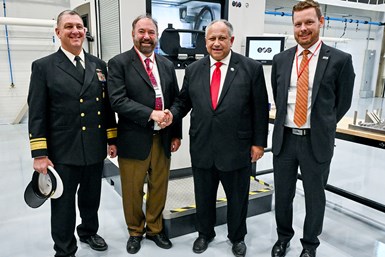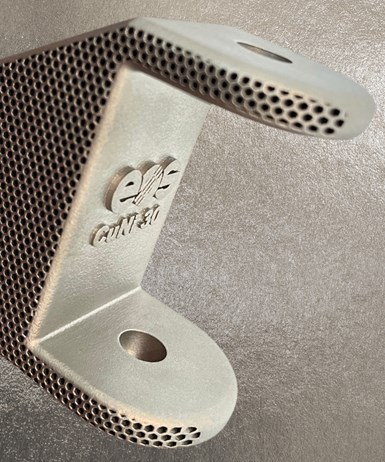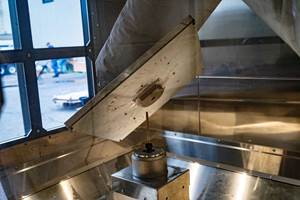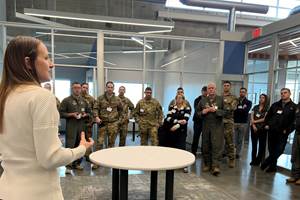EOS Works With Phillips Federal, Austal USA to Develop CopperAlloy CuNi30 for US Navy Submarine Industrial Base
Using the copper-nickel alloy in combination with EOS’ platforms offers new design and production capabilities for U.S. Navy submarines, while also enabling the agency to limit global supply chain disruption because parts can be produced regionally, locally and on-demand.
(left to right) Admiral Scott Pappano; President of Phillips Corp. Alan Phillips; Secretary of the Navy, Carlos Del Toro; Sr. Vice President Global Additive John Harrison. Source: Phillips Corp.
Working with Phillips Federal and Austal USA, EOS has developed a copper-nickel (CuNi) material for the U.S. Navy Submarine Industrial Base (SIB) to mitigate casting supply chain delays. The material was tested and developed to meet the goal of “2+1 Columbia and Virginia Class submarine platforms” for the U.S. Navy.
The copper-nickel alloy meets UNS C96400 specifications and was engineered specifically for laser powder bed fusion (LPBF) industrial additive manufacturing (AM). It is well suited for the marine, energy and chemical industries, providing excellent corrosion resistance in salt water and sustained performance in low temperatures.
The CuNi30 material was developed and tested to alleviate the supply pressure of traditional castings. Source: EOS
The material in combination with EOS’ platforms offers new design and production capabilities for U.S. Navy submarines, while also enabling the agency to curb global supply chain disruption because parts can be produced regionally, locally and on-demand. The material is now available commercially.
EOS CopperAlloy CuNi30 delivers excellent performance and material properties with a combination of high strength and ductility, around 510 MPa UTS and more than 20% elongation. The material achieves excellent corrosion resistance in salt water and sustained performance in low temperatures. With these mechanical properties, EOS has successfully met UNS C96400 specifications as mentioned in ASTM B369-09 for mechanical performance.
The CuNi30 material was developed and tested to alleviate the supply pressure of traditional castings and meet the goal of “2+1 Columbia and Virginia Class submarine platforms” for the U.S. Navy. Phillips Federal notes that the material’s exceptional performance combined with the competitive cost-per-part (CPP) has created a strong business case for production implementation.
“EOS was provided with a strategic objective to deliver a CuNi30 product to the U.S. Navy submarine industrial base to mitigate casting delays; a material holding unique to the naval construction industry and not widely available for AM technology use,” says Dr. Ankit Saharan, senior manager of metals technology at EOS. “We acted with priority to support the submarine program schedule, and we are pleased to share our successful product release within a few months of the project start. It is a privilege to contribute to projects of such strategic importance to our national interests.”
Supply Chain Efficiencies, Accelerated Lead Times and Reduced Inventories
Traditionally, manufacturing of CuNi alloy applications is done by casting and can be costly due to testing and quality requirements. There is also a lack of suppliers who can meet the application requirements. With the combination of EOS CopperAlloy CuNi30 and the quality and productivity of EOS platforms, these applications can now meet both requirements, while also opening new design and production capabilities industrial 3D printing affords manufacturers. The fact that parts can now be produced regionally, locally and on-demand is another huge advantage.
“We are grateful for the response from EOS and the Additive Minds team to develop EOS CopperAlloy CuNi30 so quickly,” says John Harrison, senior vice president of global additive at Phillips Federal. “This alloy is critical in many marine applications and will be important in our efforts to support the U.S. Navy Center of Excellence.”
EOS CopperAlloy CuNi30 is now commercially available for the midframe EOS M 290 and the large frame EOS M 400, followed by the four-laser EOS M 400-4 later in 2024.
Related Content
The Cold Spray Solution to the Casting, Forging Supply Chains
Startup HAMR Industries performs additive manufacturing work at Neighborhood 91 that provides an alternative to traditional casting and forging. Success so far has led to redefining the limits of its additive equipment.
Read MoreThe Top 10 Additive Manufacturing Stories of 2024
Defense, space exploration, thermal management — these are some of the topics that captured the Additive Manufacturing audience’s interest in 2024. But there’s also an overarching theme: Don't wait for additive manufacturing to be perfect. Instead, leverage the applications perfect for AM.
Read MoreQuadrus: Powder Management Tactics for Tungsten Rhenium and Other AM Alloys
The expert in additive manufacturing of high-value parts for the Defense Department often must change from one exotic material to another in its powder bed machines. Cleaning is a core competency. Here are lessons of this company’s system for working with an ever-changing mix of 3D printed alloys.
Read MoreHow a DOD-Funded Resilient Manufacturing Ecosystem (RME) Is Coming Together at Neighborhood 91
Pittsburgh’s additive manufacturing campus doubles as a test bed for a Department of Defense project aimed at developing a reproducible ecosystem for on-demand production of critical parts.
Read MoreRead Next
Crushable Lattices: The Lightweight Structures That Will Protect an Interplanetary Payload
NASA uses laser powder bed fusion plus chemical etching to create the lattice forms engineered to keep Mars rocks safe during a crash landing on Earth.
Read MoreProfilometry-Based Indentation Plastometry (PIP) as an Alternative to Standard Tensile Testing
UK-based Plastometrex offers a benchtop testing device utilizing PIP to quickly and easily analyze the yield strength, tensile strength and uniform elongation of samples and even printed parts. The solution is particularly useful for additive manufacturing.
Read More3D Printed Polymer EOAT Increases Safety of Cobots
Contract manufacturer Anubis 3D applies polymer 3D printing processes to manufacture cobot tooling that is lightweight, smooth and safer for human interaction.
Read More






















